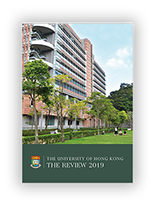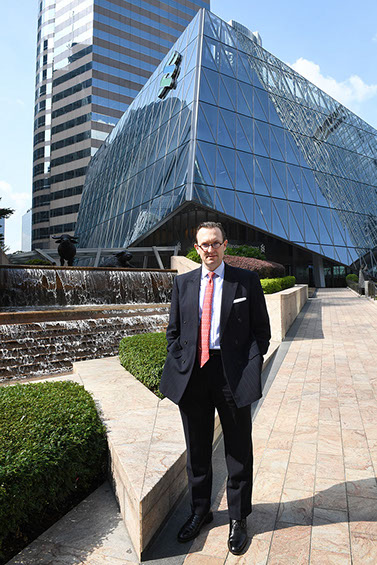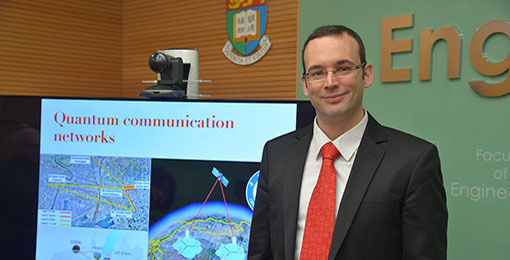Research and Innovation
2018_%20.png?crc=3873734352)
PDF Version
Past Issues
Vision and Mission
An Extract from
the University’s
Annual Accounts 2018–19
The University Profile
Officers of the University
The Court
Teaching and Learning
Research and Innovation
Knowledge Exchange and
Technology Transfer
Message from the
President and
Vice-Chancellor
E-Book

Focused on Impact
HKU’s combination of talent and funding, and a willingness to be innovative, were recognised in the 2018–19 Research Impact Fund when seven HKU-led projects received a total of more than $45 million. A select sample of our impact in academia and beyond is presented here.
FinTech as an Inclusion Solution
Some 1.7 billion people in the world still lack access to the banking system. Research by Professor Douglas Arner in the Faculty of Law and his collaborators outlined how financial technology could be applied to maximise financial inclusion and potentially transform financial systems. Their report formed the basis of a strategy adopted by the Alliance for Financial Inclusion (AFI) in autumn 2018. The AFI comprises more than 90 central banks and financial regulatory authorities from around the world.
“Rather than focusing on those people who were excluded, we analysed the factors that led to more than 1.2 billion people coming into the formal financial system for the first time between 2010 and 2018 by acquiring a bank or mobile money account. From that, we proposed a strategy that is based on four pillars: digital identification, electronic payments, government-to-person digital strategies, and digital financial infrastructure,” Professor Arner said.
As well as being adopted by AFI, the strategy influenced the content of the Sochi Accord: FinTech for Financial Inclusion, which was agreed by AFI’s full membership in September 2018 and by the Intergovernmental Group of Twenty-Four on International Monetary Affairs and Development (G-24) in October 2018. The strategy has also been presented by AFI at various regional meetings of bankers over the past year.

Professor Douglas Arner’s research focuses on the application of financial technology to transform financial systems.
Understanding Cause and Effect at the Quantum Level
Cause-effect relations are identified by formulating different hypotheses and testing them against each other – for example, testing a new drug against a placebo in patients. Classical approaches to this problem, however, have proven inadequate when it comes to quantum phenomena, where responses to interventions can differ strikingly from those of classical random variables. Professor Giulio Chiribella of the Department of Computer Science and his student Daniel Ebler showed a way around this limitation by designing new quantum algorithms to discover cause-effect relations.

Research by Professor Giulio Chiribella shows that quantum algorithms offer powerful advantages over all classical algorithms when it comes to discovering cause-effect relations.
Professor Chiribella and Mr Ebler showed that because quantum particles can travel along many paths at the same time, they can be arranged to simultaneously explore multiple experimental setups and test them in new ways. This reduces the probability of errors exponentially compared with classical setups and means that cause-effect relations can be determined more quickly than before. The research is expected to have broad application, such as the design of intelligent quantum machines and future communication networks that can speedily identify the presence of communication links.
Language Project Brings Unexpected Benefits
Dr Cathryn Donohue in the Department of Linguistics has been working to preserve an endangered Tibeto-Burman language called Nubri. In addition to research papers, she has developed descriptive materials for vocabulary and grammar and a growing archive of audio and video recordings of Nubri, documenting the language and the culture. But the lifestyle of the Nubri people posed a challenge to developing a writing system that would further help preserve the language.
Any successful writing system requires community involvement and consensus, but the 2,000 or so Nubri speakers are largely subsistence farmers spread out across Nepal’s remote Nubri Valley, which is about a week’s walk from the nearest road and four days’ walk from one end of the valley to the other. Younger generations have been moving away for schooling that is largely taught in Nepali. Dr Donohue needed to find a way to entice the Nubri speakers to congregate and give input to her project.
Her innovative solution was to focus on healthcare, particularly eye care, which the community was in dire need of. She organised eye clinics that flew in doctors to screen 499 valley residents, who then set up a surgical clinic to treat patients with cataracts. The project not only restored the patients’ vision and independence, it benefited Dr Donohue’s research and the wider Nubri community. “The clinics were a necessary catalyst to bring the community together to discuss orthographic options. It was also an opportunity to record traditional medicinal practices as well as interview many of the villagers, establishing more clearly the vitality of the language,” she said. “The longer-term impact of preserving this language is incalculable and a small victory in a world losing its linguistic diversity at an alarming rate of an estimated one language every fortnight.”
-crop-u41494.jpg?crc=4175438170)
A photo exhibition by Dr Cathryn Donohue showing the awe-inspiring people and scenery encountered during the knowledge exchange project involving the eye clinics in Nubri Valley.